A multi-vendor marketplace is a platform where many sellers or providers offer products or services. Such platforms have a greater audience reach, scalability, and profitability than single-vendor marketplaces. That is why entrepreneurs turn to multi-vendor marketplaces as profitable business ideas.
Multi-vendor marketplaces target sellers and buyers and process thousands of transactions daily. Buyers, sellers, and admins must manage products, handle orders, and communicate smoothly. So, well-thought-out multi-vendor marketplace features are core to running the platform successfully.
As experts in building marketplace websites, we are happy to share tips about the functionality of your multi-vendor platform to help you thrive. With these features, you will grow your audience by providing a fruitful environment for sellers and buyers. Let’s delve into it.
1. Quick onboarding
You have probably heard the term “onboarding” before. Do you know what it means in terms of ecommerce? In a nutshell, onboarding is the process of integrating new users into your online marketplace solution. In our case, it refers to helping sellers get started.
When building an ecommerce website, your task is to make onboarding plain and simple, even for newbies. Suppliers do not want to waste their time. They need to start selling their products right there, right now. If it takes too much time and effort to begin trading, they leave your platform and move to competitors.
Offer sellers the right tools and efficient training to make them stay. Show them how they can manage their accounts smoothly. Teach suppliers to be independent and self-sufficient.
If everything is done right, you can gain their trust and build a long-term partnership with your vendors. So, your B2B (business-to-business) marketplace startup will thrive.
Etsy knows how to encourage sellers to join the platform. Their excellent support and education multi-vendor marketplace feature is what new users need to get started. Etsy’s ‘Success Newsletter’ and ‘Seller Handbook’ contain useful tips. With their help, vendors can learn how to run a successful online store.
Also, the multi-vendor marketplace gives suppliers access to powerful tools that help them manage and grow their business.
Finally, the Etsy website offers inspiring Seller Stories. The success of other entrepreneurs will encourage users to open their own online stores.
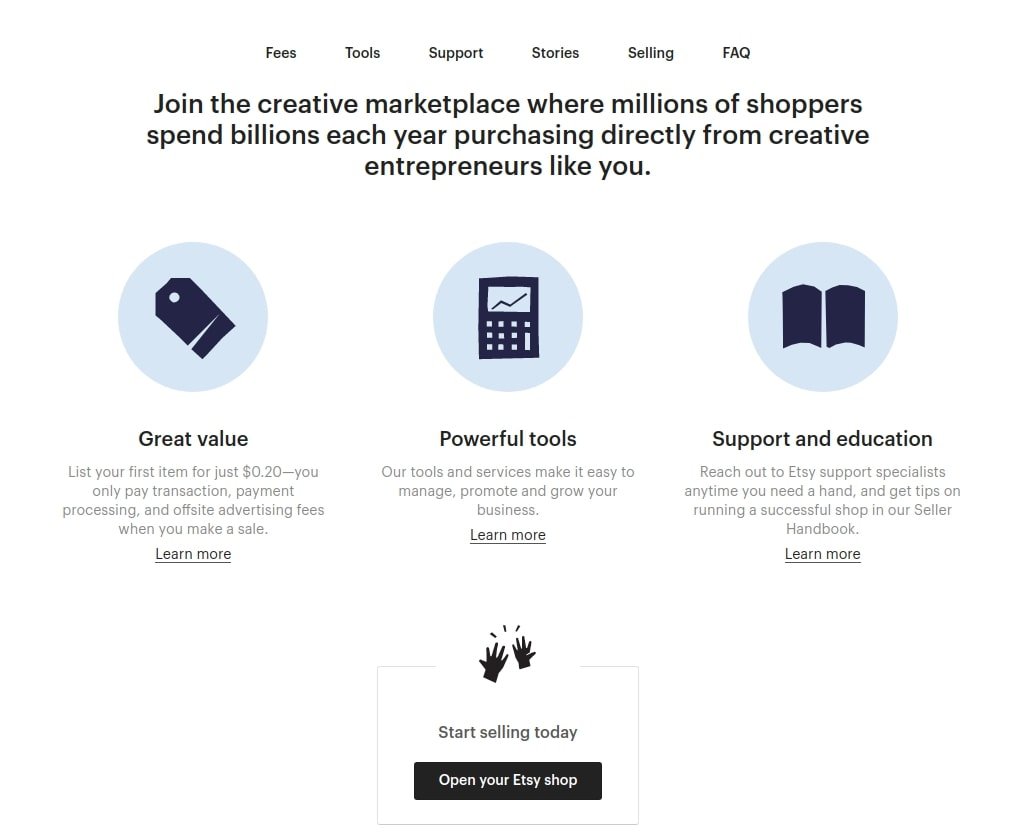
2. Detailed vendor’s profile page
Undoubtedly, this is a must-have marketplace feature for sellers. The vendor profile should be informative to the max on your platform. Remember that the full profile is a sure-fire way to prove the credibility of a particular seller. For this purpose, let vendors add and edit company details such as name, email, and social media links. Include the relevant features in your multi-vendor marketplace development.
Besides, publishing customers’ reviews on the vendor’s page would be a sound idea. With their help, sellers can improve their offers, provide better customer care, and navigate marketplace trends.
Remember to leave room for customization when working on this multi-vendor marketplace feature. Sellers should be able to customize their individual online stores with their own branding colors, fonts, styles, and logos. This will help them stand out from competitors.
Finally, make sure that vendors can perform the following actions on their page:
- Manage their account;
- Edit and manage items in stores;
- Choose the most suitable shipping option;
- Add notes to orders;
- View orders and their statuses.

3. Product listing management as a must-have marketplace feature for sellers
The revenue of your online marketplace largely depends on the quantity of the sold items. So, vendors should be able to publish products for sale effortlessly. Starting a multi-vendor marketplace, follow the tips below. Thus, you will provide sellers with seamless listing management.
Customize the listing page
You should allow sellers to update their catalogs when necessary. For example, if vendors need to add a new product or remove items, you should give them this opportunity.
Focus on the quality of the listings
It is worth noting that you must take care of the quality of the listings. This has a significant impact on your marketplace's reputation. For this purpose, ensure only qualified sellers can operate on your ecommerce marketplace platform.
Also, consider that there are restricted products that need the website administrator's approval. Only in this case can buyers see them.
Amazon is noted for its strict Restricted Products Policy. It explains what products are illegal, unsafe, or restricted. These items include:
- Alcohol;
- Food and beverage;
- Medical devices and accessories;
- Weapons;
- Gambling and lottery;
- Tobacco and tobacco-related products;
- Surveillance equipment.
It would be a great idea to add import/export functionality. Sometimes, this multi-vendor marketplace feature may become a silver bullet for sellers.
Suppose vendors need to migrate from their systems to your ecommerce platform. They will not have to import or export the data manually. Instead, sellers will have an automated system that will make things easier.
You may follow the lead of Bonanza, one of the largest online ecommerce platforms. It synced its marketplace with eBay, Amazon, Etsy, and Shopify. In this way, vendors can quickly bring their product listings from these websites to their Bonanza vendor account.
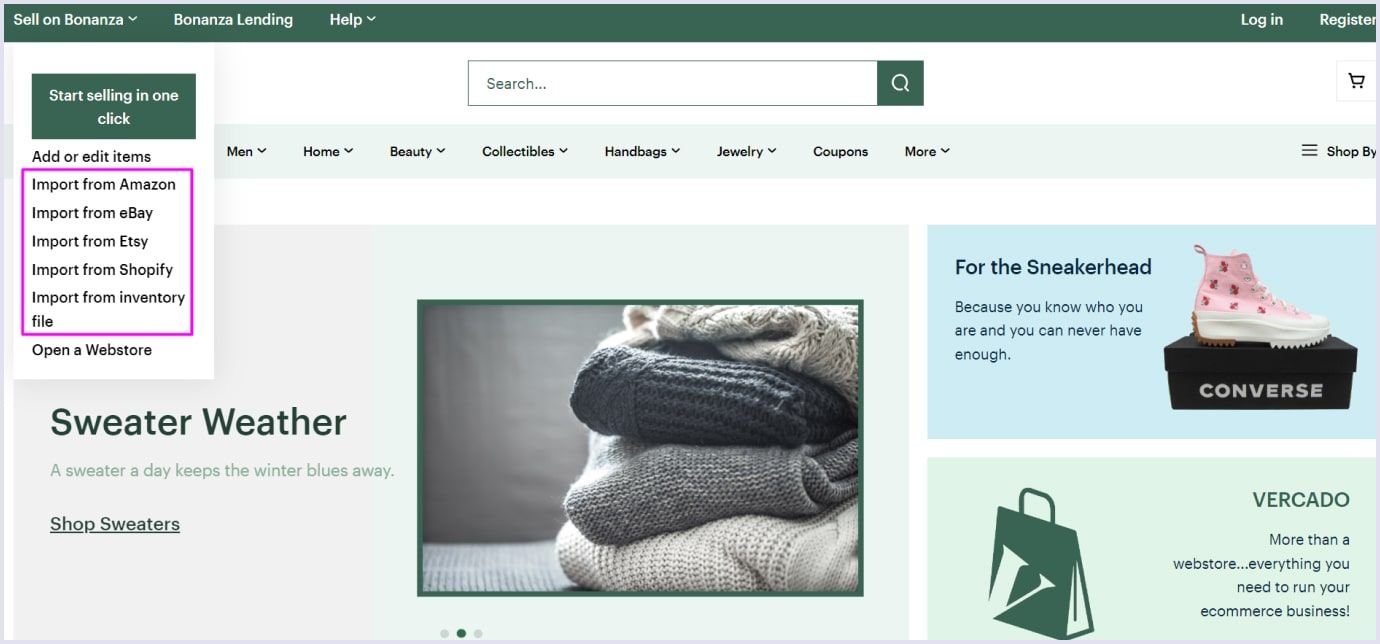
4. Convenient order management system
Sellers need to keep track of the stock level for each product they offer. Therefore, a simple order management system becomes a vital multi-vendor ecommerce marketplace solution.
With its help, vendors will avoid issues with conflicting and unfulfillable orders. For example, buyers can be prevented from placing an order that cannot be fulfilled. In addition, sellers can automatically update stock levels each time a purchase has been made. So, consider adding this feature to your multi-vendor marketplace design.
Vendors should always ensure that buyers get the desired item on time. This way, they can prove to customers the credibility of their business and increase the chances of repeat purchases.
The sure fire way to escape issues with lost or undelivered orders is to track the current status of a delivery. Convenient order management system should easily cope with this task.
For example, this feature for marketplace sellers should allow vendors to send messages to buyers. They should be informed about the status of their order. Thus, customers will know that the order has been processed successfully and the item has been shipped.
Related reading: Top Strategies to Attract Sellers to Your Peer to Peer Marketplace
5. Analytical dashboard
Sellers should be able to measure their business's efficiency. That’s when an intuitive analytical dashboard can save the day, even if you start with a marketplace MVP. This feature for a multi-vendor B2B marketplace allows suppliers to get reports on sales and customers.
The most important stats and data related to buyers’ behavior include:
- Best selling products;
- Non-performing items and categories;
- Session time;
- Number of views and purchases;
- Actions of buyers.
For example, the Joom multi-vendor marketplace helps sellers check for sales, traffic, product ranking, promo analytics, and refund rates.
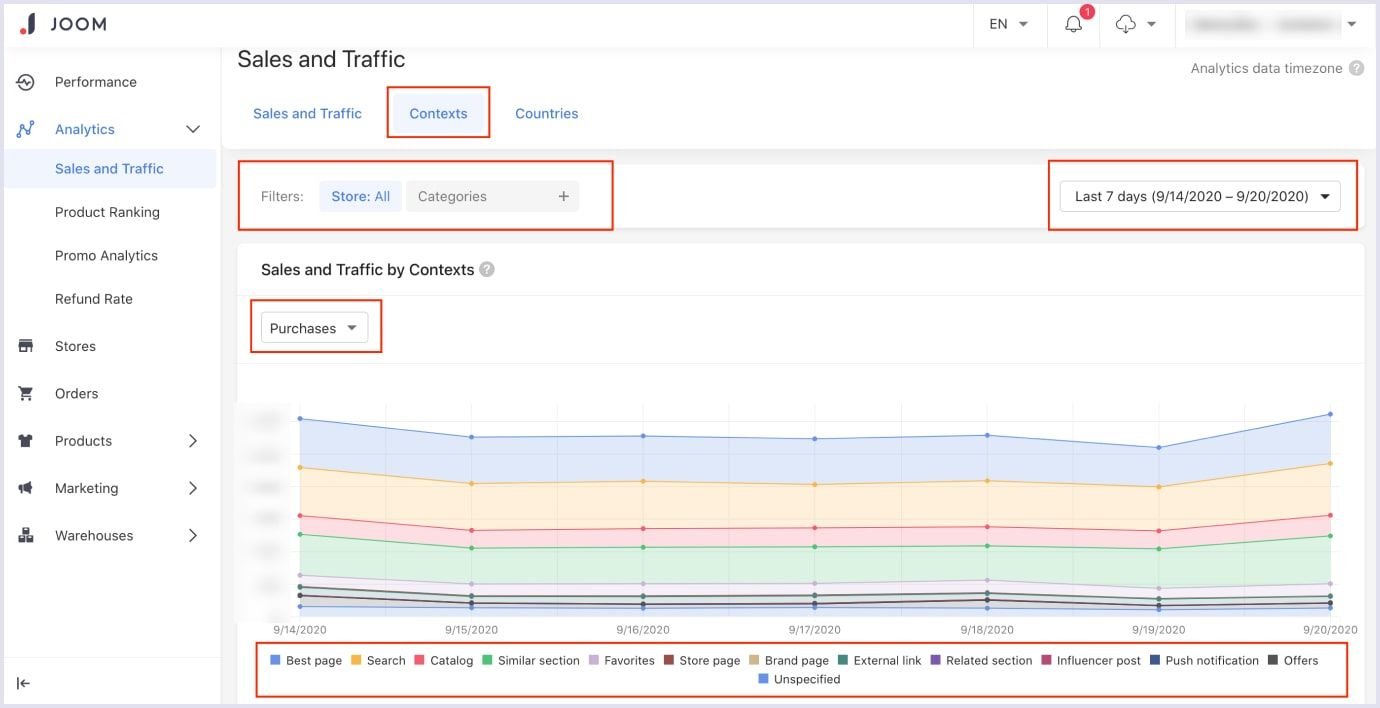
Thanks to these insights, vendors can offer better customer service. Besides, the statistics gathered will help vendors update their promotion strategies accordingly. With each successful seller, your online marketplace will become increasingly profitable.
It should be noted that the analytical tools also allow vendors to track their inventory levels and view the account balance, including payouts and commissions.
Related reading: AI in Ecommerce: Statistics, Use Cases, and Benefits
6. Products promotion options
There are likely to be multiple suppliers on your ecommerce platform. Each vendor will try to find their own ways to grab customers’ attention. They will adopt different marketing strategies to promote their products and services on your marketplace and increase sales.
Let’s take a look at the most efficient promotional techniques.
Mailing and subscription. With these methods onboard, vendors can effectively reach their customers. Buyers are updated about discounts available in specific stores, new arrivals, and promotional deals. Besides, vendors can include recommended items based on customers’ shopping experiences.
Loyalty programs, including discount campaigns and coupons. This option leads to repeat purchases and can even mount an average order value. With double points and coupon codes, your sellers will generate higher revenue.
With a well-thought-out strategy, Rakuten helps its vendors to promote their shops. It is a great way to gain new buyers and encourage existing customers to make repeat purchases.
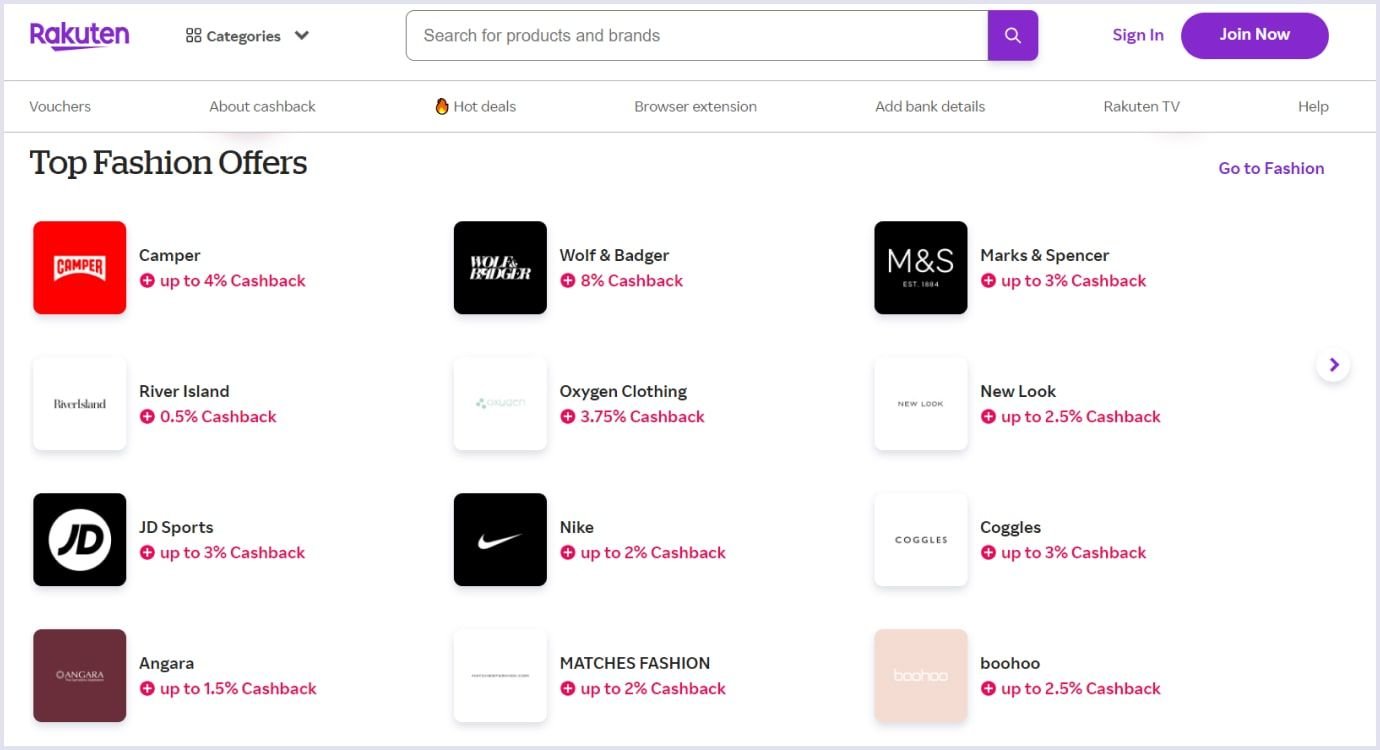
Adding detailed descriptions, high-quality photos, and videos. The visual component is more important than we are used to thinking. Let your vendors upload eye-catching images and videos and add detailed product descriptions. The visually appealing content serves as a useful multi-vendor marketplace feature. It helps make your online marketplace recognizable and more trustworthy.
Buying sponsored product ads. You can follow Tradeaboat's lead. It is an online marketplace for boats loved in Australia. The platform charges sellers for putting their products higher in search results. This tactic is efficient since it improves the visibility of product listings on your ecommerce website. Buyers can easily find sponsored goods and make a purchase.
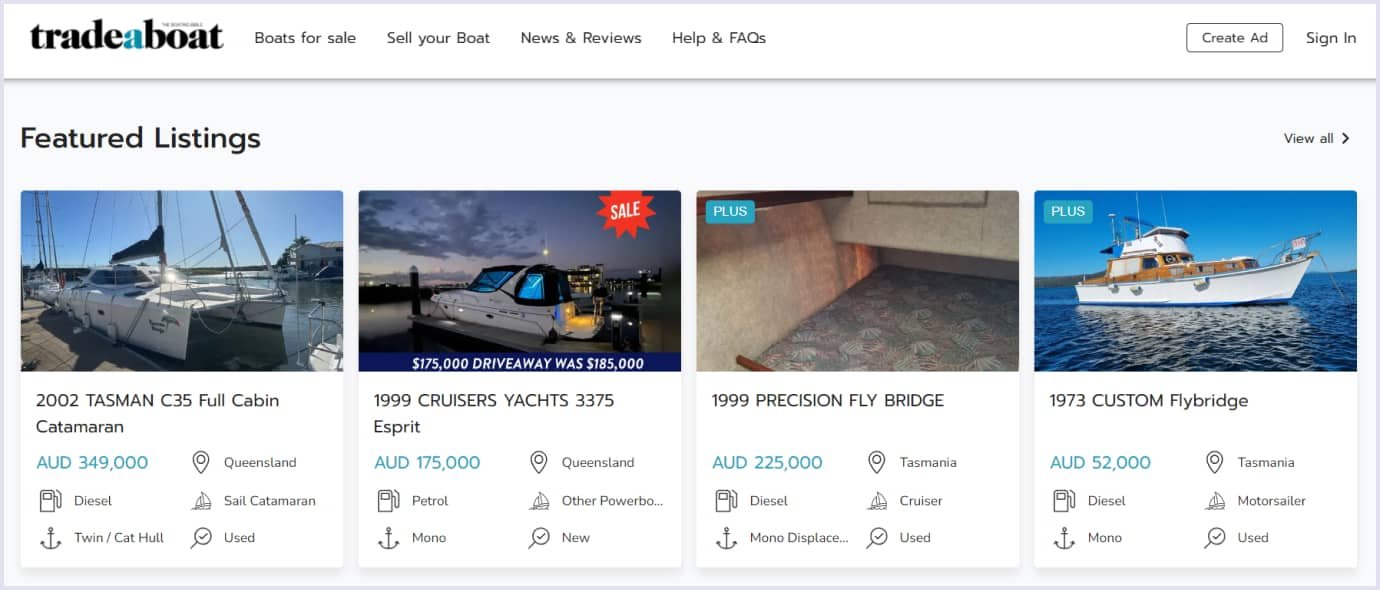
7. Payment systems
As multi-vendor marketplaces process daily transactions, they need secure and flexible payment systems. Today, multi-vendor marketplaces use several methods to speed up payments and ensure safety. Let’s discuss the approaches in more detail.
Escrow payments
Multi-vendor marketplaces use escrow services to fulfill the transaction properly and lawfully. How does it work? When a buyer sends a payment, the marketplace holds the amount in its escrow account. The funds are released after the buyer confirms the proper quality of products or services.
This service involves two levels of verification. First, it checks if the buyer's payment is authentic and secure. Second, it verifies whether the seller or provider fulfilled their obligations. Such protection against fraud helps marketplaces perform even big-ticket transactions.
Escrow services are integral to prominent C2C (consumer-to-consumer) and P2P (peer-to-peer) marketplaces. They are Uber, Airbnb, BlaBlaCar, eBay, and others.
Mass payouts
This multi-vendor ecommerce marketplace solution allows money to be sent to many recipients at once. So, a marketplace can process payments to many recipients in one transaction. Mass payouts are excellent for simplifying settlements for gig marketplaces, ecommerce marketplaces, freelance platforms, affiliate marketing networks, and crowdfunding platforms.
Prominent services that support mass payouts include Stripe Connect, PayPal for Marketplaces, Adyen for Platforms, and Mangopay. For example, PayPal integrates with eBay, Poshmark, BigCommerce, and WooCommerce.
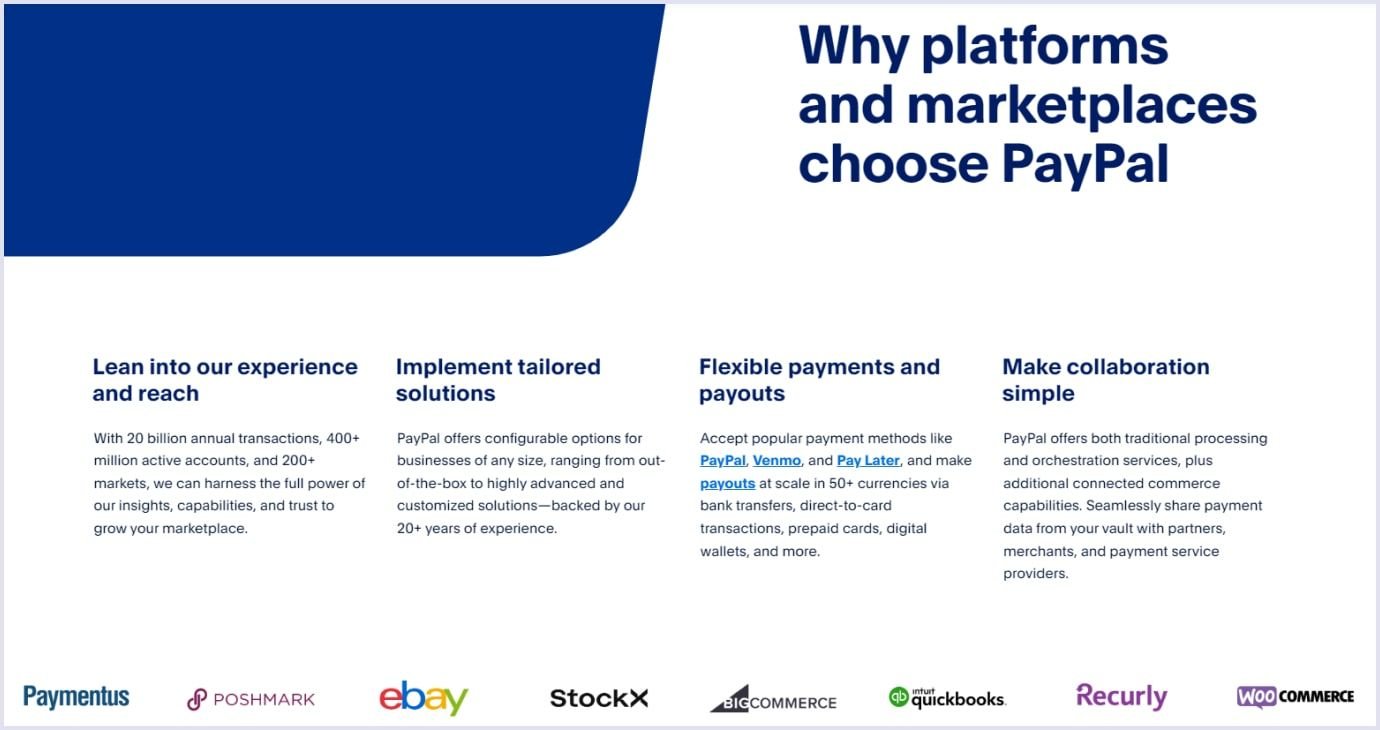
Split payments
When you pay with different payment assets for the same order or when you pay several sellers in one order, it is a split payment. Using this method, the marketplace cuts commissions and other applicable deductions. As a result, marketplace buyers and sellers can pay and get payments in one transaction for several items or services.
Digital wallets
These software-based systems store credit card details, bank account information, and digital currency. You can use them to pay online and offline with a connected device.
Digital wallets can be used for mass payouts in multi-vendor marketplaces. Sellers can link their digital wallets to the marketplace. So, vendors will receive mass payouts managed by the marketplace operator.
Apple Pay, Google Pay, and Samsung Pay are widely used digital wallets. Prominent marketplaces also implemented their e-wallets, such as Amazon Pay, Walmart Pay, and Alipay. You can use them on the relevant marketplaces.

8. Inventory management
Handling stock helps sellers see which items should be replenished and the trends in demand. Moreover, inventory management integrations for multi-vendor marketplaces help you manage perishable products. So, if your vendors sell food or groceries, such automation helps them track and ship products before expiration.
For example, Linnworks is a multi-vendor ecommerce marketplace solution. It helps retailers streamline their order and inventory management processes. The solution offers the following advantages for inventory management:
Real-time tracking and managing inventory across different warehouses and locations; Updating selling channels whenever new inventory is available; Obtaining data to make informed inventory acquiring and planning; Easy reordering and stock replenishment.
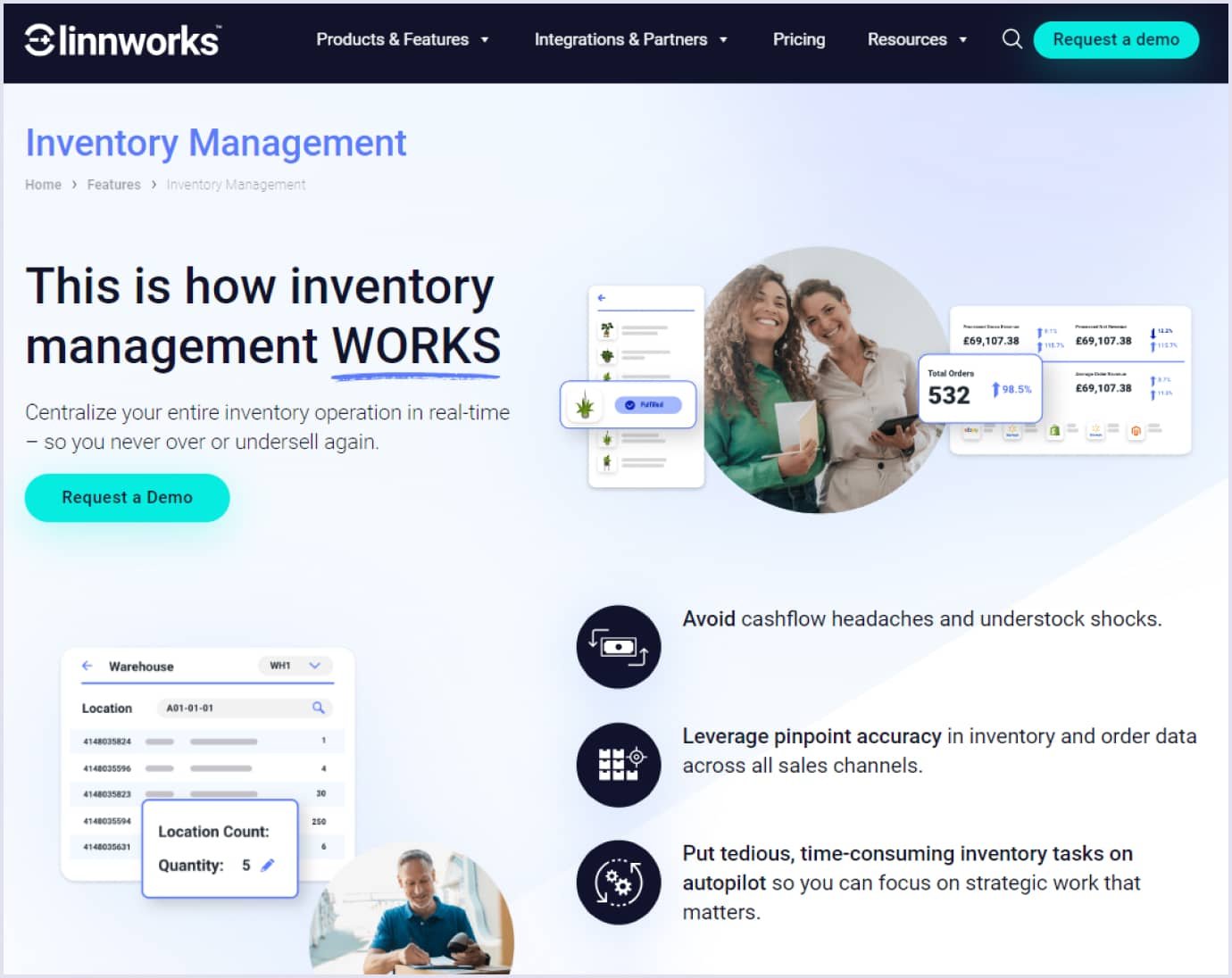
9. Featured products to attract shoppers
Selecting featured products serves the marketplace’s selling goals and strategy of attracting more buyers. So, marketplace managers feature products based on specific criteria.
You can select featured products based on seasonal promotions, holiday sales, and themed events. Multi-vendor marketplaces also feature bestselling or new products. Thus, marketplaces create curated experiences for buyers and reward sellers who offer the best products.
For example, Amazon established the Featured Offer for sellers, formerly Buy Box. This multi-vendor ecommerce marketplace solution encourages sellers to provide high-quality products. Thus, it enhances customer experience on the platform.
Amazon specifies eligibility criteria that ensure a top-notch buyer experience. Sellers should offer free and quick shipping and keep products in stock. They should also set competitive prices and ensure excellent customer service. Also, the platform supports sellers in meeting the Featured Offer criteria. Sellers can achieve that by setting competitive prices and providing high-quality products. The video below explains how sellers on Amazon can become eligible for the Featured Offer and the platform’s support in this.
10. Notifications for sellers and buyers
Sending notifications to buyers and sellers helps keep them up-to-date on crucial aspects. Marketplaces send shoppers notifications on product updates, sales, discounts, and order tracking. On the other hand, sellers learn about new orders, price adjustments, product arrivals, inventory updates, and promotions.
For example, Joom allows customers to subscribe to notifications. They include discounts, order info, price alerts, and recommendations. Also, the platform supports email notifications, which users can select or deselect.

11. Communications and feedback system
Feedback helps marketplaces operating online highlight products’ properties and assess services. By reviewing feedback from previous shoppers, customers can decide if the product is worth buying. So, marketplaces improve user experience and grow sales from this feature for marketplace sellers and buyers. Marketplaces allow shoppers to assess items and services. You can give a specific number of stars, leave a review, and show that others’ reviews were helpful or unhelpful. Also, multi-vendor marketplaces verify contact details to help shoppers contact sellers directly. For example, eBay provides a feedback system for both sides, sellers and buyers. The platform includes detailed seller ratings and the opportunity to leave a review.
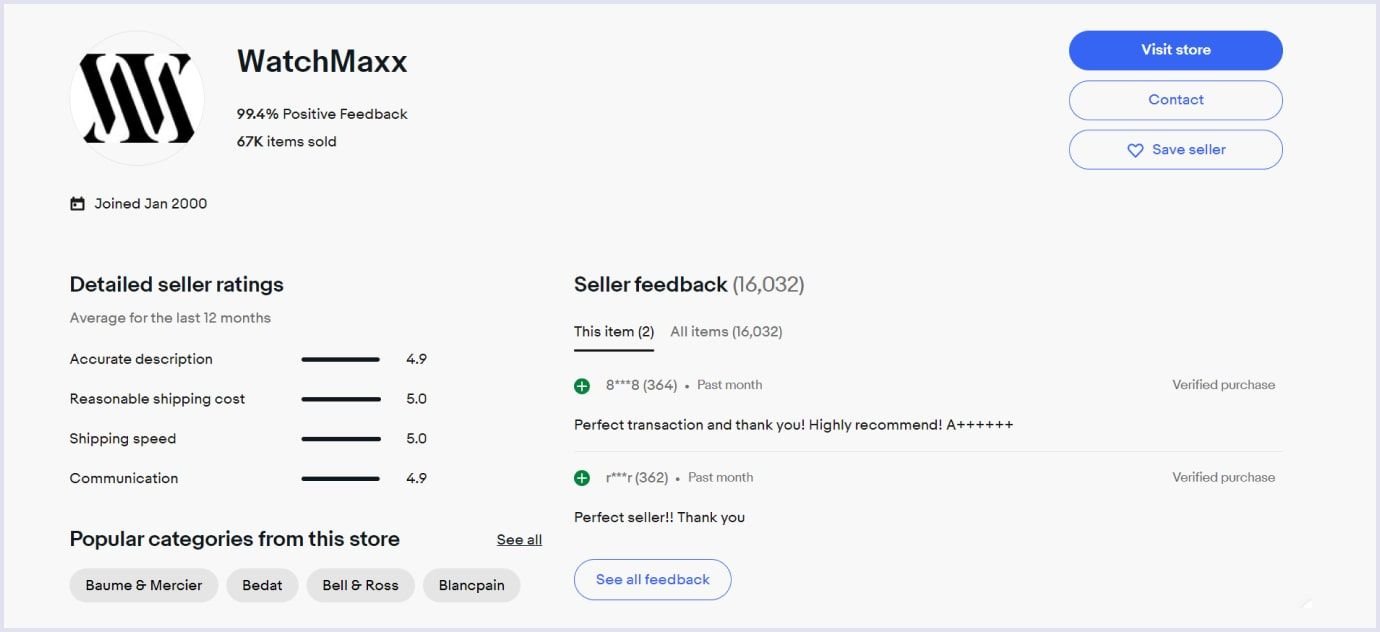
What is excellent about eBay’s feedback system, it promotes resolving issues without leaving a negative review. The platform encourages buyers to reach out to sellers and tell about negative experiences. So, sellers get fewer negative reviews and have a better chance to continue their businesses.
Bottom line
We have discussed the most required marketplace features for sellers and buyers. These are quick onboarding, a detailed vendor page, product listings, an order management system, and more. Also, do not forget about the analytics of consumers' behavior and promotional features.
Together, these multi-vendor marketplace features make up a successful and profitable ecommerce platform your sellers and buyers will love.
Codica knows everything about successful online marketplace development. If you have an idea for a multi-vendor marketplace, contact us. We will gladly make it a reality.
